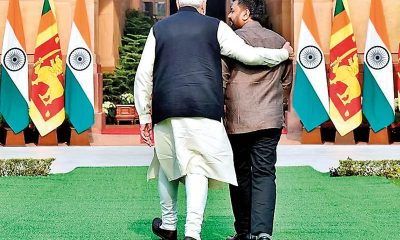Opinion
Sajith, wake up!

Power cuts lasting seven hours, kilometres long lines for petrol, the same for cooking gas and milk food. Buses stalling on roads for lack of fuel. Throngs of young applicants at the passport office. Empty shelves at supermarkets and pharmacies. Farmers setting fire to their fields, fishermen protesting on the streets. Strikes by every category of public servants. Poor, elderly patients turned away from government hospitals.
A clueless, bankrupt government that has run out of ideas. Or did not have any to begin with, other than a greed for power, a license to fleece and steal. Whose left hand does not know what the right hand does. Surviving from day to day. Buying fuel on monthly loans, like running up credit at the village sillara kadey.
The hopeless despair of ordinary people. A father, unable to feed his children, killing himself. Children set off to school hungry, because rice and bread are out of reach.
Soon, desperate people will storm grocery stores, create a run on banks as the rupee sinks, and steal crops from fields and gardens.
Meanwhile, the Leader of the Opposition delivers long speeches in Parliament, carried away by his own eloquence, speeches that remain merely rhetorical. Touring the country handing out cheques to temples (Really! Who cares at a time like this), and medical equipment to hospitals, a good deed, but with no impact on empty stomachs and lost hopes?
A nation crying for hands-on leadership, and Sajith Premadasa appears unable to provide it. Being Mr. Nice Guy doesn’t work anymore. What we need is a leader who can inspire people to pour out into the streets, to march onto Colombo, and lay siege to the lairs of the corrupt. As I write, Hirunika Premachadra has led a protest right onto the doorstep of the leader of the pack.
Sajith, ask people from all corners of the country to start marching now to Colombo. No need to ferry them in buses. They will be fed, clothed, cheered on, and joined by the suffering masses. You must lead from the front. Appeal to the police and the armed forces not to use illegal means to stop the marchers. If you get arrested, Sarath Fonseka or Champika Ranawaka will take over.
A few rats – Wimal, Gammanpila, et al – have been kicked out. Others are leaving the sinking ship. This is the time for action, not rhetoric.
Or, are you waiting for the JVP to take the initiative? Or, if the rumours are true, cutting deals with the ruling family?
GEORGE BRAINE
Opinion
Boxing day tsunami:Unforgettable experience

The first and only tsunami that Sri Lanka experienced was on Boxing Day(26th) of December 2004. My wife and I, as usual, went down to Modara in Moratuwa to purchase our seafood requirements of seafood from our familiar fishmonger, Siltin, from whom we had been buying fish for a long time. Sometimes we used to take a couple of friends of ours. But on this day, it was only both of us that went on this trip.
We made our purchases and were returning home and when we came up to the Dehiwala bridge, many people were looking down at the canal from both sides of the bridge. This was strange, as normally if there was something unusual, it would be on one side.
Anyway, we came home unaware of anything that had happened. A school friend of mine (sadly he is no longer with us) telephoned me and asked whether I was aware of what had happened. When I answered him in the negative, he told me to switch on the TV and watch. Then when I did so and saw what was happening, I was shocked. But still I did not know that we had just managed to escape being swept away by the tsunami.
Later, when I telephoned Siltin and asked him, he said that both of us had a narrow escape. Soon after we had left in our car, the tsunami had invaded the shore with a terrifying wave and taken away everything of the fishmongers, including their stalls, the fish, weighing scales and money. The fishmongers had managed to run to safety.
This had been about five minutes after we had left. So, it was a narrow shave to have escaped the wrath of the demining tsunami( the name many Sri Lankans came to know after it hit our island very badly}
HM NISSANKA WARAKAULLE
Opinion
Shocking jumbo deaths

Sri Lanka has recorded a staggering 375 elephant deaths in the past eleven and a half months due to a multitude of causes, according to the Department of Wildlife Conservation. U. L Thaufeeq, Deputy Director – Elephant Conservation said the deaths include 74 from gunshots, 53 from electrocution, 49 from hakka patas (explosive devices hidden in food), seven from poisoning, 10 from train accidents, three from a road accident, and six by drowning. It makes such diabolical reading!
“The causes of other deaths are due to natural causes or causes that could not be identified. Most of the elephants that died were young,” the official said.
Meanwhile, the human-elephant conflict has also taken a toll on people, with 149 human deaths reported this year.
Accordingly, human-elephant conflict has resulted in 524 deaths of both elephants and humans in 2024.
In 2023, a total of 488 elephants and 184 people have died consequent to the conflict, according to Wildlife Department statistics.
The human-elephant conflict in Sri Lanka has escalated to unprecedented levels with reasons like habitat destruction, encroachment, and the lack of sustainable coexistence measures contributing to the issue.
This is an indictment of the Wildlife Department for just giving the sad yearly statistics of shocking losses of our National treasures !
Given the fact that Sri Lanka boasts of 29.9% of the country declared as protected forests, Sri Lanka is a haven for nature lovers. Boasting 26 national parks, 10 nature reserves including 3 strict nature reserves, and 61 sanctuaries, the national parks in Sri Lanka offer an incredible variety of wildlife experiences.
Taken in that context, the million dollar question is why on earth the Wildlife Department is not being proactive to capture these magnificent animals and transport them into protected sanctuaries, thus effectively minimising dangers to villagers ?
Being a Buddhist country primarily, to turn a blind eye to these avoidable tragic deaths to mankind and wild elephants, we should be ashamed !
As a practising Buddhist myself, I think our clergy could play a major part in calling upon the Wildlife Department to get their act together sooner rather than later to protect human elephant conflicts !
Sri Lanka being a favourite destination amongst foreign tourists, they are bound to take a dim view of what is happening on the ground!
If the top brass in the responsible department are not doing their job properly, may be there is a case for the new President to intervene before it gets worse!
All animal lovers hope and pray the New Year will usher in a well coordinated plan of action put in place to ensure the well being of wildlife and villagers !
Sunil Dharmabandhu
Wales, UK
Opinion
Laws and regulations pertaining to civil aviation in SL, CAASL

This has reference to the article from the Aircraft Owners and Operators Sri Lanka, titled ‘Closer look at regulatory oversight and its impact on Tourism’, published on Tuesday, 24th December 2024.To explain further, in the beginning there was the Air Navigation Act No 15 of 1950 which was followed by the Air Navigation Regulations (ANR) of 1955. This was long before the national airline had acquired pressurised aircraft, intercontinental jets, sophisticated navigation equipment, satellite communication and automatic landing systems, and ‘glass’ flight-deck instrumentation.
Today, civil aviation in Sri Lanka is governed by Civil Aviation Act Number 14 of 2010. Yet the Air Navigation Regulations (ANR) promulgated back in 1955 remain in force.
These outdated regulations still stipulate rules forbidding the carriage of passengers on the airplane’s wings or undercarriage (landing gear). In short, they are neither practical nor user-friendly. In contrast, the Air Navigation Regulations of other countries have progressed and are easy to read, understand, and implement.
To overcome the problem of outdated regulations, as an interim measure in 1969 the then Minister of Communications and Transport, Mr E.L.B. Hurulle issued a Government Gazette notification declaring that the Standard and Recommended Procedures (SARPs) in Annexes to the ICAO Convention signed by Ceylon in 1944 shall be made law.
Even so, nothing much was done to move with the times until updating of the Civil Aviation Act 14 of 2010, while the Air Navigation Regulations remained unchanged since 1955. However, these regulations were modified from time to time by the promulgation of Implementing Standards (IS) and General Directives (GDs) which were blindly ‘cut and pasted’ by the Civil Aviation Authority of Sri Lanka (CAASL), from the ICAO (International Civil Aviation Organisation) Annexe ‘SARPS’ without much thought given. To date there are literally 99 IS’s starting from 2010.
The currently effective air navigation regulations are not in one document like the rest of the world, but all over the place and difficult for the flying public to follow as they are not regularly updated. This sad situation seems to have been noticed by the current regime.
The National Tourism Policy of the ruling NPP states, “Domestic air operations are currently limited due to high cost and regulatory restrictions. The current regulatory and operational environment will be reviewed to ensure domestic air connectivity to major tourist destinations. The potential of operating a domestic air schedule with multiple operators is proposed. Additionally, domestic airports and water aerodromes in potential key areas will be further developed, for high-end tourism growth.”
“The tourism policy recognises Sri Lanka’s potential to develop Sri Lanka’s aviation-based specialised tourism products, including fun flying, hot air ballooning, paragliding, parachuting and skydiving, and scenic seaplane operations. To facilitate the growth of these niche markets, existing regulations will be reviewed with the aim of attracting capable investors to develop and operate these offerings.”
It remains to be seen whether the NPP government lives up to those promises.
Note:
That OPA report talks of two funds: ‘Connectivity’ and ‘Viability’ for a limited period like three or five years to help jump-start the domestic aviation industry.
The ‘Connectivity Fund’ will cap the seat price for local passengers to a more affordable value to destinations while the ‘Viability Fund’ will assume that all seats are occupied and compensate the operator for any unutilised seat. The intention is to popularise domestic aviation as a safe, quick and convenient mode of transport.
Capt. Gihan A Fernando
RCyAF/ SLAF, Air Ceylon, Air Lanka, Singapore Airlines and Sri Lankan Airlines.
Now A Fun Flier
-

 Sports5 days ago
Sports5 days agoPathirana set to sling his way into Kiwi hearts
-

 News3 days ago
News3 days agoOffice of CDS likely to be scrapped; top defence changes on the cards
-

 News6 days ago
News6 days agoSL issues USD 10.4 bn macro-linked bonds
-

 Editorial6 days ago
Editorial6 days agoRanil’s advice
-

 Editorial5 days ago
Editorial5 days agoThe games they play
-

 Features3 days ago
Features3 days agoAn Absurd play in Parliament: Qualifications versus education
-

 Features5 days ago
Features5 days agoThe Government’s Term Tests & Results: The Good, the Bad and the Ugly
-

 Opinion4 days ago
Opinion4 days agoWhat AKD and NPP should bear in mind











